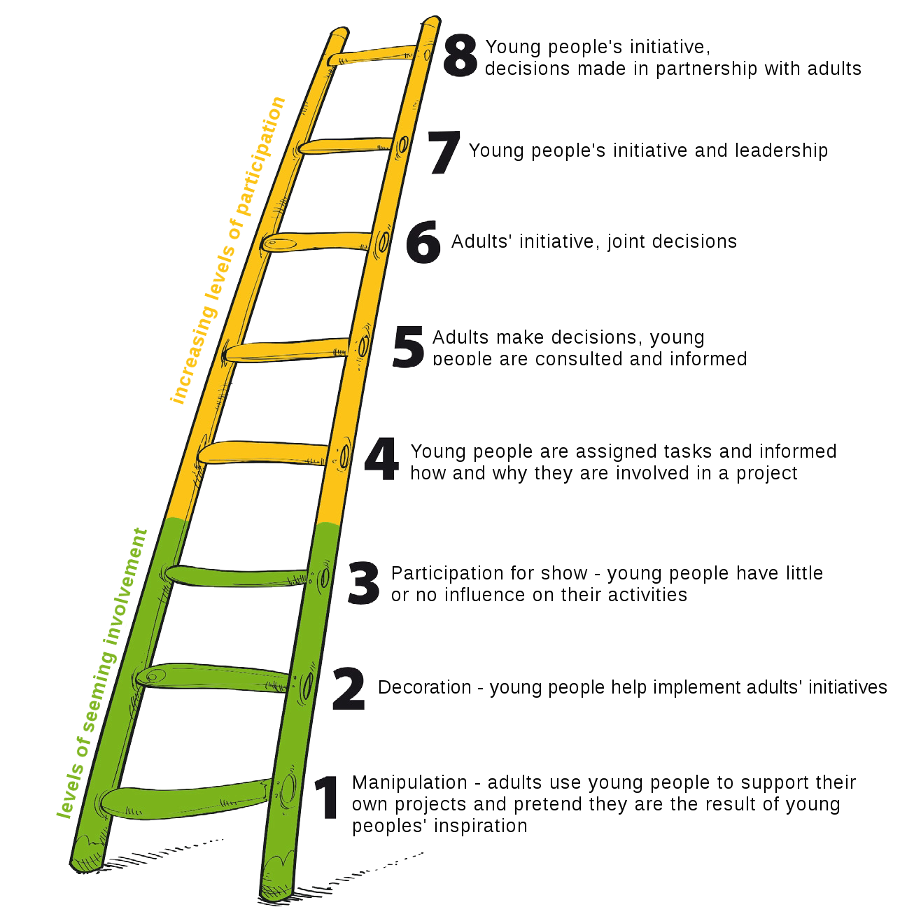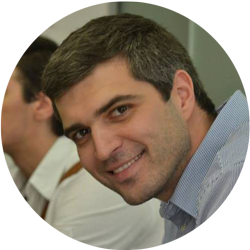Ladder of Youth Participation
The Ladder of Participation is a model developed by Hart (1992) which identifies eight levels of young people’s participation. This tool is important for recognizing the level of young people’s participation. This ladder is designed to encourage anybody willing to work with young people to rethink the process of participation and inclusion of young people in any activity.

Roger Hart defines participation as “the process of sharing decisions which affect one’s life and the community in which one lives”. Nowadays, young people are more encouraged to participate in different actions and activities in society than in the past years. On the European level, there is a constant growth of the inclusion of young people in decision-making processes mostly processes that directly affect the youth. [1]However, due to the rise of youth participation in society and as well the existence of regulative on national and European level that is more open and ready to include young people, it becomes really important to define the type and the level of participation.
The ladder of participation helps the trainer or anybody who is organizing or holding a project for young people to critically evaluate the process. Moreover, he or she can reflect on the level of inclusion of young people in different activities or actions. Also, it can help each person to evaluate its personal awareness about the level of someone’s participation. It is not rare to think that as trainer or organization, you are including and encouraging youth participation when in reality it’s just one of the levels of participation. Facing the ignorance of the different levels, it is crucially important to become self-conscious about misjudging and labeling activities and actions as participation, when in reality it’s just one level of participation.
A trainer or a learner can evaluate each activity organized or participated on the ladder of participation.
[1] The situation of Young People in the European Union, part 5, page 84 (link)

Cut the examples, fold the answer, mix them and try to guess which level they refer to. Then check your answer.
Levels of non-participation (seeming involvement) |
|
| Manipulation | Ex. An example of manipulation is a situation where children are consulted but given no feedback at all. The most common method is for children to make drawings of something, such as their ideal playground. Adults collect the drawings and in some hidden manner synthesize the ideas to come up with ‘the children’s design’ for a playground. The process of analysis is not shared with the children and is usually not even made transparent to other adults. The children have no idea how their ideas were used. |
| Decoration | Ex. Giving t-shirts to young people to represent someone’s idea or motto without consulting them or asking them about their opinion on the matter. Young people are used as decorative figures in fake creation of youth-inclusive activity. |
| Tokenism | Ex. Tokenism might be a way to describe how children are sometimes used on conference panels. Articulate, charming children are selected by adults to sit on a panel with little or no substantive preparation on the subject and no consultation with their peers who, it is implied, they represent. If no explanation is given to the audience or to the children of how they were selected, and which children’s perspectives they represent, this is usually sufficient indication that a project is not truly an example of participation. |
| Levels of participation | |
| Assigned but informed | Ex. Adults decide on the project and young people volunteer for it. Young people understand the project and adults respect their views. |
| Consulted and informed | Ex. Young people sometimes work as consultants for adults in a manner that has great integrity. The project is designed and run by adults, but children understand the process and their opinions are treated seriously. An interesting example is available from the corporate world, a useful reminder that genuine participation experiences are important for all children in all settings. At Nickelodeon, a television company based in New York, new ideas for television programs are sometimes designed in consultation with children. |
| Adult-initiated shared decisions with young people |
Ex. A community coordinator asks young people for event ideas for Youth Week. The young people suggest having a skating event. The coordinator and young people work together to make decisions and apply for funding. |
| Young people-initiated and directed | Ex. A group of students gets permission from the principal to run an environmental day. The students make the decisions and the schools provide support. |
| Young people-initiated, shared decisions with adults | Ex. Young people decide the need one-stop-shop in their village. They partner with adults from different organizations and together lobby the government for resources. |
Why did I choose this tool?
I chose this tool because it helps a trainer or a learner to evaluate and reflect on every activity that has been organized or participated in. It can be used as a tool for critical evaluation of certain activities. A group of young people can reflect on each activity and give share experience when they thought they participated in youth-friendly and youth-inclusive activity before knowing the ladder and afterward when the ladder and the levels have been explained.
Reflection questions:
In which activities that you consider as a high level of participation have you taken part?
How do you create an activity that represents a high level of participation?
How much are learners aware of being tokens, decorative figures or manipulated in certain activities?
What do you need to do to move from one level of the ladder to another?
Exercises:
– Describe what you would say to a friend that doesn’t want to vote in elections? She doesn’t believe that voting will change anything and that no one from the candidates does not relate to her personal goals and work.
– Take a group of learners and ask them to think of the last action for a cause they had? Share your personal experience as well. How would you make a difference if it was a decoration, manipulation or true youth participation?






